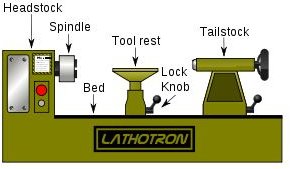What is a Lathe Machine? History, Parts, and Operation
What is this Thing Called the Lathe Machine?
Machining is one of the most important material removal methods in the technology of manufacturing. It is basically a collection of material working processes that involves other processes such as drilling, shaping, sawing, planning, reaming, and grinding among others. Machining is practically a part of the manufacture of all metals and other materials such as plastics, and wood as well. An important machine that is useful in machining is the lathe machine.
A lathe machine is generally used in metalworking, metal spinning, woodturning, and glassworking. The various operations that it can perform include the following: sanding, cutting, knurling, drilling, and deforming of tools that are employed in creating objects which have symmetry about the axis of rotation. Some of the most common products of the lathe machine are crankshafts, camshafts, table legs, bowls, and candlestick holders.
The first lathe machine that was ever developed was the two-person lathe machine which was designed by the Egyptians in about 1300 BC. Primarily, there are two things that are achieved in this lathe machine set-up. The first is the turning of the wood working piece manually by a rope; and the second is the cutting of shapes in the wood by the use of a sharp tool. As civilizations progressed, there have been constant modifications and improvements over the original two-person lathe machine, most importantly on the production of the rotary motion.
The production of the rotary motion therefore evolved according to the following procedures: the Egyptians manual turning by hand; the Romans addition of a turning bow; the introduction of the pedal in the Middle Ages; the use of the steam engines during the Industrial Revolution; the employment of individual electric motors in the 19th and mid 20th centuries; and the latest of which is the adaption of numerically controlled mechanisms in controlling the lathe machine.
For the lathe machine to function and perform its operations, various important parts are integrated together. These essentials parts make up the lathe machine and include the following:
Stand (or legs). This is used in holding the lathe machine and in elevating the lathe bed to a working height.
Bed. This is usually a horizontal beam that holds the chips and the swarfs.
Headstock. The headstock contains the high precision bearings which hold the horizontal axle, more commonly known as the spindle.
Spindle. This is a hollow horizontal axle with interior and exterior threads on the inboard by which the woodworking pieces can be mounted on.
Tailstock. This is the counterpart of the headstock which contains a non-rotating barrel that can slide in and out directly in line with headstock spindle parallel to the axis of the bed.
Carriage. This is composed of a saddle and an apron and is used as a mount to the cross-slide.
Cross-slide. This is a flat piece that sits crosswise on the bed which can be cranked at right angles with the bed.
Tool Post. Sits on top of the cross-slide and holds the cutting tool in place.
Tool Rest. A horizontal area in line with the spindle and the tailstock from which hand tools are braced against and levered into the workpieces.
